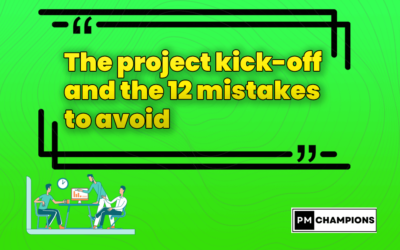Stakes of project closure
1/ Avoid being solicited on subjects that are finished and on which there is no longer any action by Delivery.

2/ Make sure everything is in order before leaving the ship for other adventures.

3/ Limit the number of project codes and facilitate the overall monitoring of ongoing activities.

Financial Closure
Action #1: Lock the project
In the project management tool, change the project to “Inactive” to prevent further timesheeting.. This must be done by the project manager when the project is completed and validated as such by a Customer Report.
Action #2: Remove the Remaining Work
The Remaining Work is supposed to be zero when the project is completed, since there is no longer any burden to spend in this context. The project manager performs the ” Remaining Work” reset operation to 0.
Action #3: Close the project
When actions #1 and #2 are carried out, and the Accrued Revenues/Prepaid Revenues and Accrued Expenses /Prepaid Expenses are balanced (see below), the management control proposes to the project manager to definitively close the project.
Definition of: Accrued Revenues/Prepaid Revenues
Here the total amount of invoices issued to customers is compared with the amount of turnover generated and valued.
Case 1 > the turnover is higher than the invoice issued
We are dealing with an Invoice to Be Issued (Accrued revenues)
- The service provider advances cash to the customer, similar to a bank, which should be avoided.
- This is a risk: an invoice to be issued can be toxic as the bill may never be issued.
- The Accrued Revenues are supposed to be cleared over time: is there a lack of follow-up?
- History can be difficult to reconstruct in order to assert one’s rights.
Case 2 > the turnover is lower than the invoice issued
We are observing an Prepaid Revenues
- Ideal location for the service provider from a cash flow point of view.
- Past production is covered, and even part of future production.
- The Prepaid Revenues is not a margin: it covers future production.
Definition of: Accrued Expenses / Prepaid Expenses
This compares the total amount of subcontracting (SST) provided for in the financial management tool with the amount of invoices received from subcontractors.
Case 1 > the subcontracting amount in the financial management tool is greater than the invoice received
We are facing a Invoice Not Received (Accrued Expenses )
- The subcontractor produced, but did not send all of its invoices
- The subcontractor made an error in the amount of an invoice
- A cost provision is made on the project on a monthly basis until receipt
- The waiting period for a supplier invoice is 3 years before releasing the “invoice not received”
Case 2 > the subcontracting amount in the financial management tool is less than the invoice received
We are seeing a Prepaid Expenses
- There is potentially an overcharging error from the supplier
- There is potentially an error in entering the Subcontracting in the financial tracking tool
- There is potentially an extension of Subcontracting that has not yet been reflected in the financial tracking tool
Condition sine qua none #1: Neither Accrued Revenues nor Prepaid Revenues
If there is an Accrued Revenues or Prepaid Revenues remaining, balance it out. There are several possibilities: send back a forgotten invoice, check invoicing transfers between project codes (without an associated budget), provision/value if the budget is in surplus or devalue the turnover (loss) as a last resort.
Condition sine qua none #2: Paid invoices
In the event of non-payment, the Sales Administration must be asked to check the lettering. Failing that, the project manager (project manager, project director, etc.) must at least be able to explain or even unblock the situation (disagreement/dispute, accounts receivable problem, misplaced invoice, etc.).
Condition sine qua none #3: Neither Accrued Expenses nor Prepaid Expenses
If there is a discrepancy, the first step is to check if the subcontracted assignment has been completed. If there is an Accrued Expenses , you have to get in touch with the supplier. If there is a Prepaid Expenses, the cause must be identified. Management control provides support in the process and the taking of corrective actions.
Delivery Closure
Action #1: Validate the end of the project

The project has been completed, but it is preferable to endorse this state of affairs. A written document is therefore strongly recommended: an end-of-project report or a confirmation email from the client fulfills this function. This is all the more important as a balance bill can depend on it.
Action #2: Measure Satisfaction

The end of a project is an opportunity to measure the satisfaction of the customer but also that of the project team. Measuring satisfaction is required regardless of the perception, positive or negative, around the project: it will lead to improvement in all cases.
Action #3: Enable communication
 The client’s agreement is necessary to be able to communicate about the service provided for him, to cite his brand and to display his logo. The project manager will ask for his permission in writing and he will forward it to the group’s communication department (which has templates if necessary).
The client’s agreement is necessary to be able to communicate about the service provided for him, to cite his brand and to display his logo. The project manager will ask for his permission in writing and he will forward it to the group’s communication department (which has templates if necessary).
Action #4: Make a Feedback
 What went well on the project? What has been missing or needs to be considered in a different way in the future? A feedback body will allow stakeholders to share and consolidate their feedback. Two feedbacks are recommended: one internally, the other with the client.
What went well on the project? What has been missing or needs to be considered in a different way in the future? A feedback body will allow stakeholders to share and consolidate their feedback. Two feedbacks are recommended: one internally, the other with the client.
Action #5: Tidy up the room
 The project is finished, but its digital life lives on in tools, servers and PCs. It is therefore time to group the documents produced in a single folder tree, taking care of the naming, the dating, and not forgetting anything. This archive may be useful at a later date.
The project is finished, but its digital life lives on in tools, servers and PCs. It is therefore time to group the documents produced in a single folder tree, taking care of the naming, the dating, and not forgetting anything. This archive may be useful at a later date.
Action #6: Passing on wealth
 In some cases, the service provider is not allowed to hold the source code of the product and is forbidden to keep the documentary components of the project: all of this must be transmitted to the client and then deleted internally. This is all the more important in the context of ISO certification.
In some cases, the service provider is not allowed to hold the source code of the product and is forbidden to keep the documentary components of the project: all of this must be transmitted to the client and then deleted internally. This is all the more important in the context of ISO certification.
Action #7: Amplify
 If the project is of strategic interest, if it is distinguished by originality, if the client is renowned, then perhaps it will be of interest to group communication: press release, blog article, intranet article, newsletter subject, etc. Contact the communications department to make sure.
If the project is of strategic interest, if it is distinguished by originality, if the client is renowned, then perhaps it will be of interest to group communication: press release, blog article, intranet article, newsletter subject, etc. Contact the communications department to make sure.
Action #8: Reference
 By filling in the essential data of the project and describing it in a few lines, the project manager can inspire others and contribute to enhancing the company’s expertise, especially during Pre-Sales.
By filling in the essential data of the project and describing it in a few lines, the project manager can inspire others and contribute to enhancing the company’s expertise, especially during Pre-Sales.
Action #9: Share
 Informing Delivery management of the end of the project is an opportunity to take action to raise awareness of the project: a production of a business case, a presentation to the Delivery community, an intervention in a Pre-Sales context, etc.
Informing Delivery management of the end of the project is an opportunity to take action to raise awareness of the project: a production of a business case, a presentation to the Delivery community, an intervention in a Pre-Sales context, etc.






0 Comments